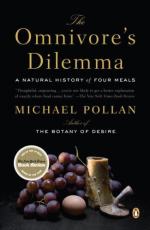
|
| Name: _________________________ | Period: ___________________ |
This test consists of 15 multiple choice questions and 5 short answer questions.
Multiple Choice Questions
1. Humans are not a perfect natural system in the food system because they can only _______ so much food.
(a) Consume.
(b) Make.
(c) Buy.
(d) Throw away.
2. Where does Pollan take his family at the end of this section of the book?
(a) Wendy's.
(b) Taco Bell.
(c) McDonald's.
(d) Burger King.
3. What is NOT one of the parts of corn that is separated out in the newly used process?
(a) Stalk.
(b) Skin.
(c) Endosperm.
(d) Germ.
4. The factories from the war time began to produce ________ for farmers to help with their crops.
(a) Wheat.
(b) GMOs.
(c) Organic blends.
(d) Fertilizers.
5. How many acres of woodland help Salatin continue to live outside the modern world?
(a) 100.
(b) 5.
(c) 450.
(d) 250.
6. Corn became a _________ because of its many applications for use by the settlers.
(a) Commodity.
(b) Problem.
(c) Fuel.
(d) Drink.
7. Corn is also able to limit the ______ lost during the process of photosynthesis, according to the book.
(a) Calories.
(b) Water.
(c) Energy.
(d) Sunlight.
8. The Naylor farm has turned from a diverse farm to one that has become a _________ production mecca.
(a) Wheat.
(b) Corn.
(c) Barley.
(d) Soybean.
9. What does Pollan admit about the chickens that Salatin sells on his farm?
(a) Higher price.
(b) Smaller size.
(c) Lower quality.
(d) Bigger breasts.
10. Pollan points out that the Republic of _______ exists today because of all of the excess corn in the market.
(a) Fat.
(b) Diabetes.
(c) Obesity.
(d) Excess.
11. Salatin's ______ invented many of the methods of farming that are used on the farm today.
(a) Brother.
(b) Father.
(c) Aunt.
(d) Mother.
12. The soda industry began to ______ their sodas, which led people to drink more and to buy more.
(a) Change the names of.
(b) Add nutrients.
(c) Add contests to.
(d) Supersize.
13. Salatin pushes for the right to opt out of ____________ of his farm, according to the book.
(a) Industrialization.
(b) Government protection.
(c) USDA rules.
(d) Colonization.
14. Salatin is a strong believer in farming in line with one's ___________, as seen in a phone call with Pollan.
(a) World view.
(b) Family.
(c) Season cycle.
(d) Horses.
15. Over time, corn has become everything humans need to be a staple of the _________ food chain.
(a) Plentiful.
(b) Hunter-gatherer.
(c) Organic.
(d) Industrialized.
Short Answer Questions
1. _________ Farm started out as a small farm that sold pre-bagged salad mix, according to the book.
2. Where does Pollan find himself first questioning what the food on the market is made of?
3. What does the farmer use to cover the chicken waste in the compost pile?
4. The farm and the human are two ________ natural systems that the food industry relies on.
5. How many generations have been at the Salatin farm, all committed to alternative farming?
|
This section contains 413 words (approx. 2 pages at 300 words per page) |

|




